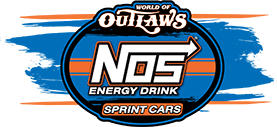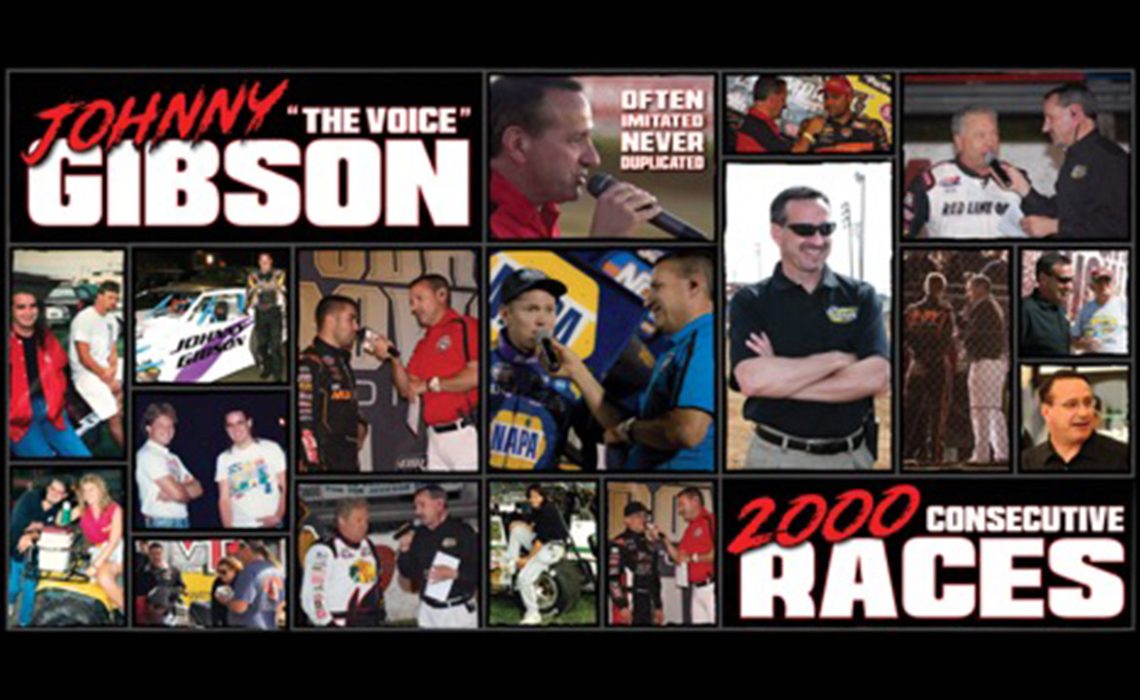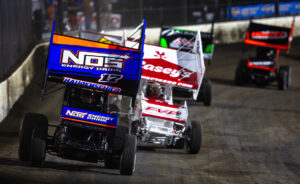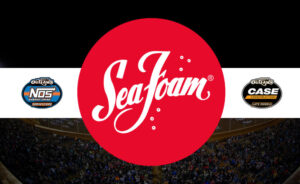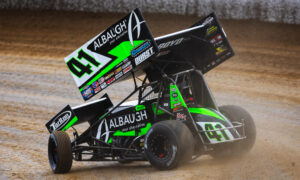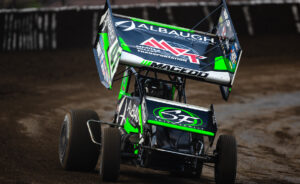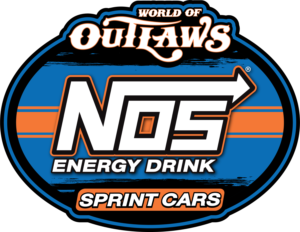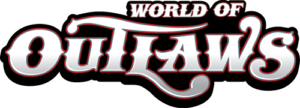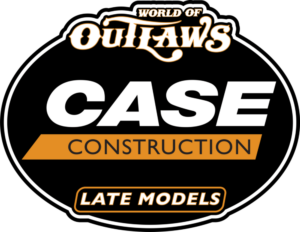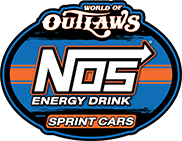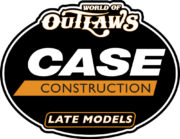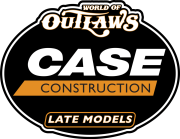Two thousand? That’s a lot of beans. Two thousand dollars to win was what it took to book the World of Outlaws when it began 42 years ago. Two thousand work nights without one absence is amazing. Now consider how the place of employ floats from coast to coast 80 times in ten months. Some nights, the office is climate controlled with electronics that mesh. Other nights require troubleshooting in the dust and heat swatting mosquitoes while trying to keep pertinent papers from blowing off the roof. To do so 2000 times borders on phenomenal. Even soul singers get “Vegas throat” occasionally. A hundred drivers have run that circuit. Car owners came and went. Mechanics, publicists, and souvenir sellers all joined the sprint car circus. Few still stand. John Gibson IV is Cal Ripken Jr. in tight white pants.
I first met the boy who would be The Voice to “The Greatest Show On Dirt” in 1987 at Windber (PA) Stadium near his Marianna home. ARDC Midgets screamed around that football field for the first time ever, just the tonic to attract Track Chasers like Guy Smith and me. Track Chasers are a peculiar strand bent on seeing races at as many places as possible. Gibson harbors that wanderlust. Even now when his Outlaw grind pauses for a moment, John will still unhook his car from its luxury bus and drive 200 miles in the opposite direction. Sure he makes the money that makes things happen but as every Outlaw knows, desire cannot be ordered from a parts brochure. On our way to Windber, John IV was described as “a drummer in a rock band” that covered Led Zeppelin so I first called him “Bonzo” because that was the nickname of their landmark percussionist John Bonham.
John Gibson III still sees 50-60 races per season. His son made insane overnight drives for no visible reason beyond impressing our “Hell Patrol” as I called us in my Speedway Scene weekly. He rode solo like now and like all outlaws, John can drive for hours without showing fatigue. I know because I’ve glanced as a sleepy passenger does to ensure their driver is not equally sleepy. All he ever seemed to need was music, cigarettes and a bottle of tea seldom finished. Some may laugh that I never learned to smoothly operate a manual transmission. Gibson drove every inch of every trip even if it entailed 750 miles to Nebraska when we banged wheels for the same girl.
My first road trip with Gibson was the 1988 USAC Midget opener in Fort Wayne, IN. Since the birth of USAC in 1956, midgets had bumped indoors on the first and third Sundays of the calendar. Fort Wayne can be 500 frozen miles from the Lehigh Valley of PA: too far even for addicts though Smith did offer a caveat. If New Year’s Day fell on Saturday, we could catch “Hangover Derby” at Sandusky (OH) Speedway on our way to the Allen County (IN) Memorial Coliseum. It was such an absurd notion that Gibson eagerly joined in. He almost lost a toe or two for his trouble for dressing too much like a rock star. His suede “Beatle Boots” were no match for the gusts from Lake Erie. His lips looked blue. We found an empty shed to block the biting wind. Guy handed him car keys to tap out, go thaw his feet. He refused. He knew we would hold it over him as only friends can.
We arrived in Fort Wayne early enough that respected journalists (plus three) were invited to a symposium on the state of midget auto racing, one sour breakfast topic then or now. A sign-in sheet circulated. Smith scrawled Area Auto Racing News where his “Roaming the Raceways” columns have appeared in four decades. I signed “Open Wheel Magazine” then passed the clipboard to John, who asked, “What publication should I say?” I answered, “You could write Creem Magazine and nobody here will care.” John chose Dirt World despite (or because) there was no such utopia.
Fast forward to Gibson’s first Chili Bowl. If Fort Wayne from Pittsburgh was perilous, Tulsa was twice as far. Yet to Oklahoma he did drive: no money, no ticket, no pit pass, only a promise to sleep on our floor. I may have hinted at how the starving artist could pose as the press. John told Beverly (Mrs. Lanny) Edwards that he was in Tulsa to cover her Chili Bowl Midget Nationals for Dirt World. “Never heard of it,” was her obvious answer. Did the writer have a copy? “Not on me, no, but I could have my editor FAX one to you.” Next morning before my aspirin, John was off to Kinko’s print shop. Later when he inserted Driver Roster sheets into Outlaw program books, Gibson would learn the location of every Kinko’s from Kannapolis to Corvallis. In Tulsa, he rented a computer to create paragraphs of praise “continued on Page 12” even though no Page 12 existed because no Dirt World existed. Beverly was off her game. John secured his three-day wristband. Many winters passed before he mustered the temerity to reveal that ruse to anyone named Hahn or Edwards though they all laugh about it now.
We tried to be last to leave any Chili Bowl. One year after enough rigs had exited the expo, Gibson parked his faithful Ford atop the ramp to add music to our party. Naturally this required leaving keys in the ignition. He soon learned that at least one Eckert can stick shift because Steve stole John’s car for a few laps around Emmett Hahn’s tractor. Gibson had his back to the spectacle and was last to know until asked, “Dude, where’s your car?” His face fell as if his beloved Pittsburgh Penguins had just lost an overtime hockey game.
Almost as impressive as John’s unbroken string of Outlaw gigs is his streak of 29 Knoxville Nationals. I did 28 straight and sang praises of five or six before Gibson got there. Again he did so unannounced with virtually no forethought. After playing some saloon, he stowed drums with the band (Trash Vegas) and drove 12 hours to Iowa to cause quite a sight: jet black hair well past his shoulders, hoop earrings, strategically ripped and re-tied T-shirt, and shredded blue jeans tucked into snakeskin boots. “Is that Tommy Lee?” someone sarcastically asked. Running on zero sleep, Gibson’s first beer put him on his back. “Great,” I selfishly thought. “Now I have to babysit this guy? Didn’t musicians make better alcoholics?” But once he rested, John IV bounced to his feet like Rocky IV. All this time and Nationals remains John’s favorite part of every year. Iron Man 55 south of St. Louis should warrant a nap yet Gibson cannot drive to his cherished slot on the Marion County Fairground fast enough. First time we rented one, Terry McCarl barged in to berate. In a few years, Terry hired Gib to his Front Row Challenge committee.
Program sales brought John Gibson to the World of Outlaws. In its first 10-12 seasons, series president Ted Johnson gave little thought to such booklets. Each season needed a month or two to even know who all to feature in it. T-shirt sales kept cash in Ted’s pocket. Then in 1990 came a new trade paper titled Sprint Car. Wayne Kindness convinced writer Bill Woodside to wheel his station wagon around America selling subscriptions. Bill added Outlaw programs to his periodical table and they sold so well that he joined the tour full-time and hired second salesmen to work bleachers or infield. That job usually went to some driver’s son or daughter eager to punch out as soon as they made arcade money.
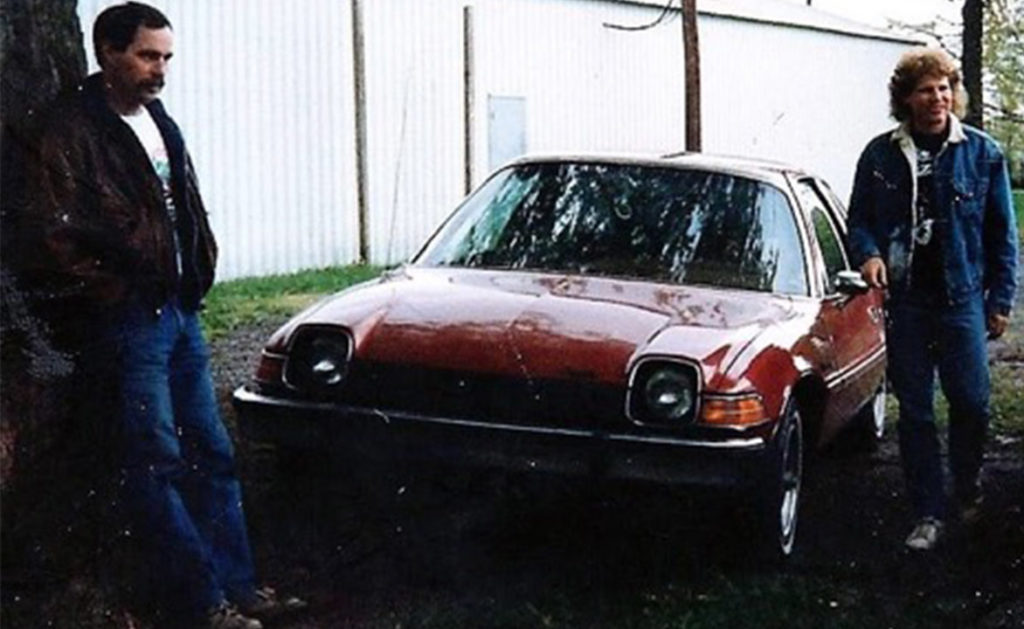
Gibson had by now (‘93-94) abandoned Pittsburgh for a futon in my Indianapolis apartment to seek some foothold in our favorite sport. Woodside was a frequent guest. Indy is “Crossroads of America” after all. Bill offered John the mobile sales. Lee Jacobs was fired at 13. Gibson embraced it. He had to because he was flat broke. He often arrived at Outlaw events without enough cash to make the next one unless he sold a hundred programs at a buck a piece. Sometimes he doubled that. Gib began to follow the circuit out of necessity. He had no other income. Woodside was handing more money to Ted Johnson than ever before. When asked why profits had spiked, Bill said, “Johnny Cat!” which was the nickname I lifted from a litter box.
Woodside liked to drink and gamble, cementing our friendship. In and around the 1995 Kings Royal (yet unsanctioned) Bill got deep into both. He mumbled something to Earl Baltes that got him physically bounced from Eldora Speedway, further bonding us. He took his new girl to a casino and hit a lucky jackpot. Flush with cash and angry about Eldora, he blew off the next Outlaw engagement in Lake Odessa, MI. Gibson did show up, so Patty Jackson offered the table. He still dabbles in sales 25 years later though that role has been vastly reduced. On nights when rain came late, we were the only outlaws making money. Gib gave me the mobile sales when I wanted.
We were rollin’ in dough. I did not enjoy stepping over people to reach people who found five dollars too excessive. Friends heckled. But hustlers could make a hundred bucks an hour. During the ‘95 Nationals, Gibson’s proposal sounded too profitable to resist. If I rode from Iowa to Montana to Washington to Oregon through California and back to Nebraska and Indiana, he would cover all gasoline and motels. We traveled in tandem with J.D Kramer, son of one car owner to Jeff Swindell, Greg Hodnett and Joe Gaerte. J.D pulled a show car in a souvenir trailer. I bounced between vehicles like a truck stop trollop, talking bored boys into a Wednesday stop on Idaho’s panhandle to see racing from an odd state. Three nights at Skagit stuffed our pockets. We swallowed crustaceans, joined a whitewater group on Oregon’s Rogue River, caught Reverend Horton Heat in San Jose, and stopped everywhere that sold used cassette tapes between Seattle and San Francisco. Our musical tastes remain compatible. Only my Ozzy or Motorhead selections got prompt ejections.
It was this same western tour in 1996 when our mutual announcer pal Bobby Gerould interviewed Gibson at Hanford, CA. Bob then needed a bathroom break so he asked John if he might like to call a heat race. Gibson leaped at the chance. Few noticed but Carlton Reimers certainly did. He had heard his father-in-law dream of his own announcer. Every club did. Ted Johnson was no different. Ted’s obstacle was justifying a reasonable wage when struggling to cover the point fund.
An incident at Cedar Lake Speedway hastened Gibson’s ascendency. Dan Motter of Minnesota signed Ecowater systems for Kenny Jacobs and gathered its employees. In its contract, Ecowater was “guaranteed” x-number of mentions over the public address but this failed to transpire. Why would it work when the guy on the microphone had no incentive? But what if Ted’s guy was already on tour? What if Gibson called the show after selling programs? Johnson was never short on stones. He hired an announcer with exactly ten laps under his belt.
We were all skeptical. Johnson had a history of handshakes gone awry plus announcers have egos. Some believe that fans pay to hear them talk. Would they stand aside on the biggest nights of their season to surrender the seat to Ted’s unproven shill? Frankly, yes, though not without some struggles. Gibson asked Bruce Flanders to mention more sponsors until Flanders dropped the mike and left the Perris Auto Speedway shouting, “Johnny Long Hair can do the whole show!” The multi-pronged cast of microphone men at Knoxville slipped John into its rotation. And at Williams Grove, Bruce Ellis said, “You call ‘em off turn four and I’ll call ‘em down the back” in a continuing compromise.
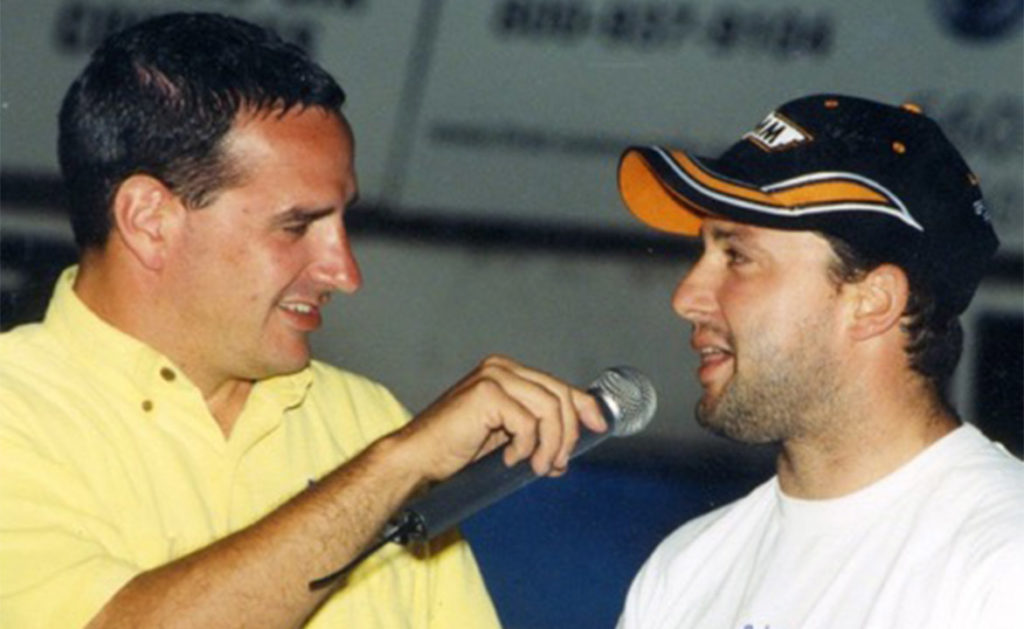
In the course of 2000 races, Gibson has bestowed many nicknames on many drivers. He gets particular pleasure when such tags are emblazoned on articles designed to fetch money. “Steel City Outlaw” Tim Shaffer spoke to John’s local pride. “Double Down” Jason Sides was inspired while watching Sides go for gusto on a blackjack table. We rolled our eyes at worse handles. But when Steve made me an uncle, I saw John’s target audience because “The Dude” and “The Wild Child” became Sully’s favorites.
We might also shake our heads at Gibson’s “Get There Now!” attitude shared by all point chasers. Sure there are cool things to enjoy between Saturday in Charlotte and Friday in Memphis but the prevailing theory is that those who stop to smell the roses risk missing the next race. If they mess around on Monday and Tuesday only to suffer transporter trouble on Wednesday, they might not race on Friday. Most drive directly from one town to the next then kill time in motels or motorhomes. It can drive men to madness. During such lulls, Gibson’s guitar skills improve. John so adores the Rolling Stones that he removed one string because that’s how Keith Richards does it.
One night after Knoxville rain, a friend from the South Skunk Blues Society suggested that our pain be tempered with a live band from a Newton lounge. One sneaky girl told the band about the famous drummer from Pittsburgh in the house. After he sat in for a song, John returned to our table. “What was that?” I asked. “I don’t know,” he shrugged. “Some blues shuffle.”
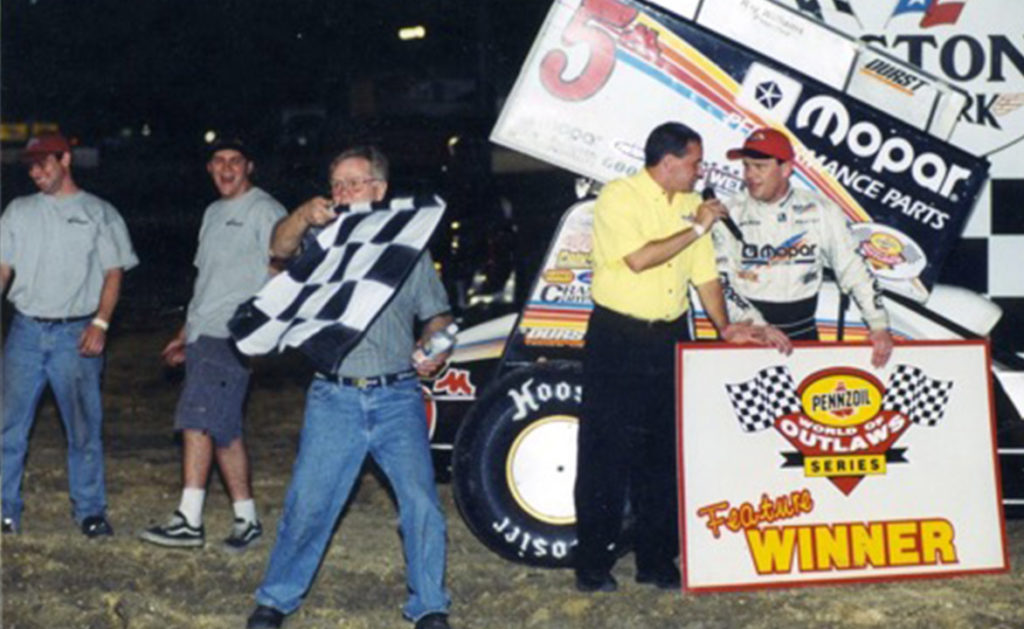
Gibson, Kramer and I reconvened in 2002 for my only trip to Australia. J.D had organized tours in previous years but suffered a shortage of customers in the wake of 9/11. Would the editor of Flat Out Illustrated like to fly Down Under in exchange for a multi-page spread? Does Kraig Kinser like provisionals? Days before boarding that plane, I was eliminated as editor yet Kramer could not have cared less. He did delay his flight to meet Jurassic Five in L.A. Gibson struck a deal to announce at Parramatta City Raceway. I got adopted by the late Shane Krikke then reunited with John at the Hotel Mercure, where his laptop screamed of injustice as my Oakland Raiders were sodomized in the snow of Foxboro’s final football game.
That was our Ratbag chapter. Ratbag was the Australian computer concern that created the first realistic video version of sprint car racing. Kramer nurtured the idea. We three sat in Melbourne with Daryn Pittman and Jeff Shepard suggesting different realities (“mud should obscure vision”) to brilliant computer geeks who wrote code on the spot. None of us could have predicted that an entire generation would come to know Gibson’s voice from a video game or my line about “widow-making machines” from a two-minute history of sprint cars.
Lots of people have lots of friends. Some friendships last a week, a month, a year. Some stand the test of time. What is a true friend? Well to this incorrigible criminal, a true friend is someone who will wake in the middle of the night, get dressed, withdraw cash, drive downtown, and bail me out of jail in the near certainty that he will never see that money again. That happened after a few hours in a holding cell. After ten months in federal custody, after both revenue streams severed relations, that same true friend put cash in my paw and told me to rebuild my search engine. I might have hugged him.
Two thousand straight races? That’s flat out ridiculous.
